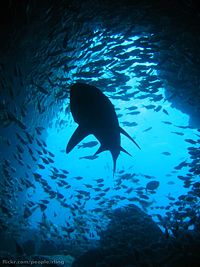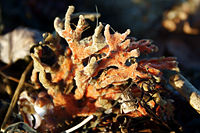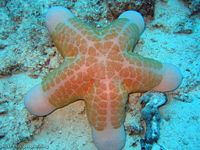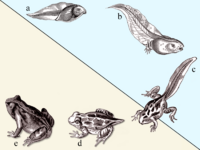Animal
| Animals | ||||||
|---|---|---|---|---|---|---|
 This grey nurse shark (Carcharias taurus) and the smaller fish surrounding it are animals.
| ||||||
| Scientific classification | ||||||
| ||||||
| Phyla | ||||||
|
Infrakingdom Eumetazoa
|
Animals (from the Latin animale and animalis, meaning "living", in turn from anima, meaning "vital breath", or "soul") are those organisms classified into the kingdom Animalia. Together they make up a wide segment of life—biologists estimate their species to number many millions—and include an incredibly diverse array of both familiar and strange creatures, ranging from hawks to humans and from sea slugs to spiders. Nonetheless, they all share certain characteristics: all animals are multicellular eukaryotes, ingest their food, and move by their own power at some point in their life cycle. Animals are essential consumers in many ecosystems and many are also important in human societies and economies.
Definition
Like "plant", the term "animal" has gone through several definitions along history. Animals—moving life—were distinguished from plants—unmoving life—by Aristotle in his works on metaphysics and logic. Aristotle continued to influence classification of plants all the way to Carl Linnaeus, who divided all life into the two kingdoms Animalia and Vegetabilia. Some animals such as coral were considered plants because they appeared sessile and similar to plants' branches. Additionally, many protists were formerly classified as "microscopic animals" because, like animals, they actively moved and ate other organisms.
Today, "animal" can specifically refer to a member of the kingdom Animalia, which is the subject of this article. However, the word is still sometimes used to include the protists, in which case they are called "unicellular animals". In addition, "animal" is often used informally to refer to those animals other than humans, which are a species of animal; sometimes a human is described as an "animal" to imply that they are savage or violent. It also sometimes refers to only mammals, a class of animal, as opposed to other animals like birds, reptiles, fish, or insects.
Characteristics
Animals share many characteristics—some of which are common to all animals, and others that are common to only a group. Despite the number of these shared characteristics, the groups that we form based on them are, in a way, misleading. Lumping animal reproduction into "sexual" and "asexual reproduction" belies the astounding amount of ways animals have found to find, court, and copulate with mates, compete with rivals, and still avoid predators at the same time. As you read what animals have in common, one should always keep in mind the incredible diversity by which they have tweaked these basic ideas.
Cells and tissues

Like plants and fungi, all animals are eukaryotic: they are comprised of cells which contain a cell nucleus. However, their cells lack cell walls that surround the cells of plants and fungi. Unlike bacteria, archaea and most protists, they are also multicellular: their bodies are made of many cells attached to one another.
Animal cells are organized into specialized, integrated arrangements called tissues, which may in turn be organized into larger structures called organs. All animals have a tissue type called epithelium, a protective layer of cells covering their bodies' surfaces.[1] Many animals also share other structures such as guts (chambers with one or more openings for digestion), muscles (organs which contract for locomotion), and nerves (tissues which transmit electrical signals between cells).
All of an animal's tissues originally develop from one, two, or three tissue layers in the embryo stage, depending upon the kind of animal it is. Sponge embryos have only one layer, while diploblasts and triploblasts have two or three, respectively. In diploblasts and triploblasts, the inner layer is called the endoderm, which develops into the gut and associated tissue, and the outer layer is called the ectoderm, which develops into skin and the nervous system. Triploblasts also have an additional layer in between the endoderm and ectoderm called the mesoderm, which develops into many internal organs such as the circulatory system, muscle, and bone.
Food and energy

In one of the many unique ways animals obtain food, rancher ants drink sugary juice from aphids in return for the aphids' protection.
Another trait common to all animals is that they are heterotrophs: they obtain nutrients by ingesting food from outside, generally digesting food in an internal chamber. This separates them from plants, algae, and other autotrophs, which do not ingest food. They are consumers that often occupy the higher levels of food chains in many ecosystems.[1] They obtain their food in a dazzling array of methods: for instance, rancher ants tend aphids and harvest the sugar that they secrete. [2]
Animals obtain food in many ways, but most can be grouped into two types. The first, predation is a biological interaction where a heterotroph, called the predator, obtains food by consuming the cells of another organism, called the prey. Predators are further split into three groups. Herbivores are predators that primarily consume autotrophs, carnivores are predators that primarily consume heterotrophs, and omnivores are predators that consume both autotrophs and heterotrophs.
Many animals also practice detritivory, where an animal consumes food from detritus: dead organic matter. Like detritivore bacteria and fungi, detritivore animals recycle nutrients and are thus important in decomposition.
The ways that animals feed on the food they obtain may be grouped into four general tactics. Suspension feeding, or filter feeding, filters out and concentrates food particles suspended in water or air, such as a baleen whale filtering out plankton. Deposit feeding swallows a substrate and ingests the microorganisms, detritus, and other cells within the substrate, such as an earthworm eats through soil. Fluid feeding sucks fluids such as body fluids from plants and animals, such as a butterfly drinking a flower's nectar. Mass feeding, or bulk feeding, eats chunks of flesh from prey into the mouth, such as a snail eating pieces of leaves. [1]
Locomotion and limbs

One final common trait of animals is that they are motile during at least one point of their life cycle. The vast majority of animals move under their own power as adults, though some adult animals, such as sponges and sea anemones, never actively move—they are sessile. Some animal predators, for instance, sit and wait for their prey to come to them—the sea anemone spends most of its life attached to a rock and captures fish and other organisms that swim by. After their larvae hatch from eggs, however, the larvae actively swim. The ability to swim away from their parents helps aid the dispersal of new young across a wider space, so it is less likely that the young will compete with their parents and each other for space and food.
Movement enables animals to actively seek out food, mates, and whatever else is desired by the animal, and escaping from predators, rather than having to stay in one place. Animals move in a large variety of ways, burrowing through the ground, slithering or crawling on a substrate, swimming through the water, or flying in the air. Likewise, the structures that power these movements are also numerous, including cilia, flagella, and muscles. The last structure, muscles, can attach to two types of skeletons to enable movement: a hard skeleton, such as the internal skeletons of the vertebrates or the external skeleton of the arthropods, or a soft hydrostatic skeleton made of water. The hydrostatic skeleton is unique to animals and permits the wriggling movements for those animals with wormlike bodies.
The limb, a controllable protrusion from the body, deserves special mention for enabling many animals to move in very controlled and rapid fashions. Some ecdysozoans, such as velvet worms and sea urchins, have either sac-like limbs or tube feet. Some annelids have bristle-like limbs called parapodia. Arthropods and vertebrates have jointed limbs which have built-in joints, at which the limb can bend in certain ways. Fins, legs, and wings fall into this last category.
Body plan
While animals share many characteristics, their bodies come in many forms. Their overall shapes are called their body plans, and to make sense of their variety, they are grouped depending on their symmetry, their gut and body cavities, and whether their bodies are segmented.
Symmetry and cephalization

Sponges are asymmetrical animals—they cannot be sliced in any way that produces similar sides.
Animals, like other multicellular organisms, can be classified on their symmetry: can their bodies be sliced into nearly identical pieces? Animals are symmetrical on zero, one, two, or more planes of symmetry. Sponges, sea squirts, and similar animals are completely asymmetrical, but virtually every other animal is symmetrical in at least one plane. Asymmetrical animals tend to be fixed to a substrate and do not actively move; they feed passively and reproduce asexually or with external fertilization.

This sea star is an example of pentaradial symmetry: symmetry in five axes.
Organisms symmetrical on more than two planes are radially symmetrical; they appear like the spokes of a bicycle wheel, and most alive today float in water or attach to substrates. The echinoderms, such as sea stars and sea urchins, are radially symmetrical as adults, but as larvae they are bilaterally symmetric.
Organisms with only one plane are bilaterally symmetrical; they have left and right sides and two ends, and they tend to possess longer and narrower bodies. Virtually all bilaterally symmetrical animals are placed into the clade Bilateria and are descended from a single ancestor long ago. They also exhibit cephalization: the development of a head on one end of the body where feeding, sensory, and processing organs are concentrated. Bilateral symmetry and cephalization are both pervasive in animals—it seems that when they were developed, the diversity of animals exploded. It is thought that they enabled animals to more actively move, hunt, and respond to the environment better. [1]
Guts and body cavities
Animals may possess a gut. A gut is often described as a "tube with a tube": a long tube or chamber running through the body with one or more openings that can take in whatever food the animal consumes and digest it. The first opening, the gut's intake, is called the animal's mouth. If a gut has a second opening, on the other end of the tube, the opening is called an anus, and it is where remaining, undigested food is ejected. In radially symmetrical animals, the mouth is often found in the center. In bilaterally symmetrical animals, the mouth is usually in the head, nearby the animal's sensory organs, and the anus is likewise found on the opposite end of the head. Animals with only a mouth have a two-way gut (also called a blind gut), because food and waste must use the same opening. Animals with both mouths and anuses have a one-way gut, which can more efficiently process food and absorb nutrients.
Animals may also contain fluid-filled cavities inside their bodies, in which the gut and other organs may float. The cavity is called a either a coelom or pseudocoelom, depending on how it is sealed. enables an animal's internal organs to move independently in it, oxygen and nutrients to circulate within it, and an animal to move without limbs as a hydrostatic skeleton. Animals are often grouped by what kind of body cavity they have. Animals with coeloms are called coelomates, animals with pseudocoeloms are called pseudocoelomates, and animals that do not have any enclosed body cavity are called acoelomates.[1]
Reproduction and life cycle

These two mating tortoise beetles give an example of internal fertilization.
Even though an animal may become especially efficient at moving and feeding, if it does not reproduce well, it may fail to make its traits more common. Thus, as with their feeding, locomotion, and body structure, animals reproduce and develop in astonishingly diverse ways. Many animals use sexual reproduction: they use meiosis to produce special cells called gametes, mate with another individual, and fuse their gametes together to form a new, genetically different individual. Some animals also can reproduce both asexually (creating clones of themselves using mitosis, without any mating involved). In addition, some animals such as the bdelloids can even only reproduce asexually, and many fish, snail, and lizard species have never been observed performing sexual reproduction.[1]
There are two types of sexual reproduction that animals may perform: internal or external fertilization. Fertilization refers to when a male gamete cell (called a sperm) fuses with a female gamete (called an ovum or egg) to form a whole new [[individual. A male animal performing internal fertilization usually inserts a special organ into a female animal and transfers sperm inside. In some animals, females themselves insert packets of sperm produced by males into their bodies and fertilize them then. In seahorses, the usual internal fertilization occurs in reverse: females insert eggs into males' bodies, and the males fertilize them inside. Animals that perform external fertilization, in contrast, send both sperm and eggs into the environment, where they fuse outside either parents.
Regardless of what kind of reproduction an animal performs, the newly formed individual starts out as one, solitary cell that divides into a new, multicellular embryo. Either one—generally the female—or both parents care for their new embryos. The majority of animals are oviparous animals, such as birds, lay fertilized, protected eggs containing embryos, which develop independently until they hatch out of their eggs. In contrast, viviparous animals, such as mammals, nourish and let their embryos grow inside them and, when they are ready, give birth to them live. Finally, ovoviviparious animals, such some insects, keep independent eggs inside their body until they hatch, giving birth to well-developed young. All three types of embryonic care enable sexually reproducing animals to help their young survive; they are especially important to land animals, who otherwise would not be able to reproduce without water.
Metamorphosis

Animal life cycles are unique for every species of animal, but one common and striking innovation many of them share is metamorphosis, where a juvenile's body transforms in shape and size into an adult body. There are two varieties of metamorphosis that animals carry out: holometabolism and hemimetabolism.
In holometabolism (also called complete metamorphosis), an animal greatly changes in appearance between its juvenile form (called the larva) and its adult form—the two forms eat different prey and behave in different ways too. In many animals, a larva often matures into a pupa, another form. Pupae do not move or feed and are surrounded by protective cases. The process of becoming a pupa is called pupation. Within their case, the animal's body is reshaped into its adult form; generally, they are often the most vulnerable to death from predation during this time. When the animal's body is ready, it breaks the case and emerges as an adult, ready to reproduce.
In hemimetabolism (also called incomplete metamorphosis), an animal grows in size from its juvenile form (called the nymph) to its adult form without greatly changing its form. Nymphs look like miniature adults, and usually feed on the same food that adults feed on.
Most animal species carry out holometabolism rather than hemimetabolism—in insects, the former is ten times more common! One explanation for this difference is that holometabolism allow larvae to feed on completely different types of food. In hemimetabolism, larvae and adults compete for the same food. Another hypothesis suggests that holometabolism allows larvae and adults to be more specialized and efficient—the former for feeding, the latter for mating. Larvae indeed typically constantly eat and do not move much, while adults move great distances. Research is currently testing these two hypotheses.
Origin and phylogeny
Animals form a clade, which means that all animals are linked through one common ancestor. This single ancestor is closely related to a group of protists called the choanoflagellates—the closest living relatives to animals. The two are part of the broader group opisthokonts, which also contain some other protozoa, and, most notably, the fungi. In the fossil record, animals become significant only after the so-called Cambrian explosion that occurred during the Lower Cambrian (around 530 million years ago), but some earlier traces of animal fossils have also been found.
In the past decade, molecular phylogeny has dramatically changed our understanding of the relationships among the many lineages of animals. Below is a summary of the currently widely accepted theory of the phylogeny of animals and how we group them to make sense of their bewildering diversity.
- The Porifera (sponges) of today are the closest, most basal animal phylum to the choanoflagellates and the first group among the surviving animals to separate from the rest. Like all animals, they possess multicellularity and epithelia, but are otherwise very different from the other animals below.
- True tissues, diploblasty, and symmetry separate the other animals from the sponges; the group of all non-sponge animals is called Metazoa.
- First up in Metazoa are the two phyla Cnidaria (jellyfish and sea anemones) and Ctenophora (comb jellies) contain animals that are radially symmetric and diploblastic.
- Eventually, some animal lineage developed bilateral symmetry, cephalization, and triploblasty. The animals descending from that lineage form a large group, called Bilateria.
- Classification of animals within Bilateria has undergone a radical reorganization in the past decades. Most animals in Bilateria now are split into two clades: the protostomes and the deuterostomes.
- Equally significantly, protostomes in turn split into two groups: the ecdysozoans and lophotrochozoans. These three groups have many fundamental differences, especially in how their embryos develop and how they grow.
- The protostomes descend from one ancestor, and are distinguished by how their embryo cells form in a spiral. The protostome lineages in the past split into two major subclades, the ecdysozoans and lophotrochozoans—both of which descend from their own single common ancestors.
- The lophotrochozoans grow by lengthening and enlarging their skeletons. They include the rotifers, flatworms, annelids (such as earthworms), and mollusks (such as clams, squid, and snails).
- The ecdysozoans grow by expanding their bodies inside external skeletons and shedding them periodically. They include the roundworms and arthropods (which include the insects, spiders, and crustaceans). The ecdysozoans—especially the insects—contain the bulk of animal species.
- The deuterostomes contain the rest of Bilateria; their embryos grow in stacks. The deuterostomes contain the echinoderms (sea stars and sand dollars) and the chordates. The chordates include all vertebrate animals: fish, amphibians, reptiles, birds, and mammals.
Animals in ecosystems
Animals act as consumers in whatever ecosystems they live in. They are thus heterotrophs and can often be found at the higher trophic levels of their ecosystems' food webs: herbivores eat plants and other producers, carnivores and omnivores eat other consumers, and detrivores feed on any dead organisms. For the vast majority of animals, the usable energy that animals need to sustain their metabolism and stay alive originally comes from the Sun. This energy was captured by producers like plants with photosynthesis, which is turn transferred to whatever animals eat them.
Animals are also important links in many biochemical cycles. For instance, animals consume the oxygen produced by light-exposed plants' photosynthesis and use it in aerobic respiration, producing carbon dioxide; carbon dioxide is in turn required for photosynthesis. In this way, plants and animals rely on each other for the gases they require to live. In addition, animals free up the carbon that plants are made of by eating, burning, and exhaling carbon dioxide into the Earth's atmosphere and hydrosphere. Plants capture this airborne carbon and use it to build themselves up. These relationships are merely a few facets of the great carbon and oxygen cycles that sustain all life on Earth.
Animals also share many direct relationships, called symbiosis, with other life. For instance, many animals—especially the insects—transfer the pollen of many flowering plants in an act called pollination, aiding the plants in reproducing. Many animals—especially parasites—are adapted to depend on a single species of animal, plant, fungi, or bacteria.
Finally, humans—a type of animal—have transformed many ecosystems on Earth. Even in ancient times, humans have changed their environment by clearing forests by burning, domesticating and farming other organisms, and damming. However, especially since the Industrial Revolution humans have altered countless ecosystems through the use of their technology, redistributing and transforming huge amounts of substances across the planet through mining, logging, manufacture, development of cities, and other economic activity (see also Ecological footprint).
Impacts on humans

Donkeys are a domesticated animal whose mechanical strength is often harnessed by humans as transportation.
Humans are one species of animal, but from their perspective the other animals are often called "animals" in contrast to themselves. In addition to the important roles they fill in countless ecosystems, the other animals also directly affect human societies and economies. Humans in every part of the world depend on other animals for food, and along with plants, many animal species have been domesticated by humans. In preindustrial societies, horses, oxen, donkeys, and other provide humans with transportation and heavy labor. Many other domesticated animals such as dogs and cats also live as human pets.
Furthermore, domesticated animals are often used as models for humans: much of our knowledge of human biology depends on our knowledge of animal biology. In the drug industry, domesticated mice, rats, and primates are used to test drugs and new medical treatments.
References
- ↑ Jump up to: 1.0 1.1 1.2 1.3 1.4 1.5 Freeman, S (2008) Biological Science, Third Edition ISBN 0-555-00399-X
- ↑ Walker J (2003) "Animal Magnetism: Aphid-Ranching Ants" [1]

